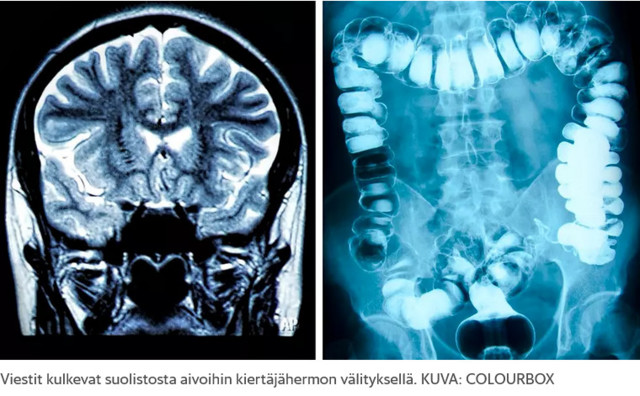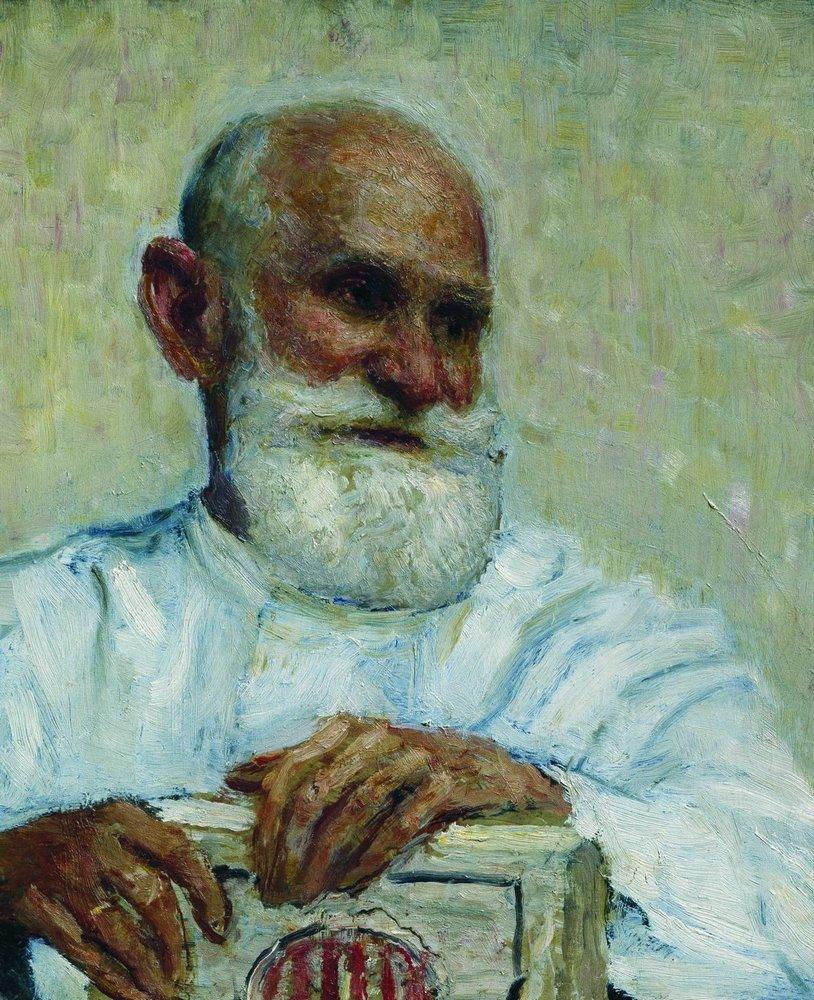HS-TYHMENTYMÄ esittelee "TÄYSIN UUTENA KEKSINTÖNÄ" toisenkin IVAN PAVLOVIN TODISTAMAN ilmiön, juurisen, JOSTA TÄMÄ SAI NOBELIN PALKINTONSA 1904: ruoansulatuskanavan suoran aivo-ohjauksen:
https://www.hs.fi/tiede/art-2000005842497.html

Viestit kulkevat suolistosta aivoihin kiertäjähermon välityksellä. (KUVA: Colourbox)
Ihmisen kaksi älyä ovat yhteydessä toisiinsa: uusi tutkimus paljasti, että suolistosta on suora hermoyhteys aivoihin
Viestit ruuansulatuksesta aivoihin vilahtavat synapsien kautta, ilman hormonien apua.
Suolistolla on paljon suorempi ja nopeampi yhteys aivoihin kuin on ajateltu. Viestit kulkevat ruuansulatuksesta aivoihin hetkessä suolistosolujen ja kiertäjähermon välisestä hermoliitoksesta, Science-lehdessä julkaistu tutkimus paljastaa.
Havainto selittää osaltaan, miksi nykyiset ruokahalua hillitsevät lääkkeet eivät aina toimi, sanoo tutkija Diego Bohorquez. Lääkkeet vaikuttavat hormoneihin eivätkä hermoliitoksiin.
Tutkijat lupailevat, että tieto voi edistää lihavuuden, syömishäiriöiden ja jopa masennuksen ja autismin hoitoa. Kaikki nämä on liitetty suoliston häiriöihin.
Havainto myös vahvistaa ajatusta, että ihmisen toinen äly asuu ruuansulatuksessa. Suolisto kytkeytyy aivoihin hermoilla, joissa viestit kulkevat nopeasti edestakaisin.
Kun edessä on vaikea tilanne, vatsaa kipristää. Kun sisuksissa on raskas ateria, aivoissa on sumuista.
Suolistossa on sata miljoonaa hermosolua eli yhtä paljon kuin selkäytimessä. Suolisto on suuri aistinelin.
Suoliston ja aivojen välinen yhteys isoa kiertäjähermoa pitkin on ennestään tunnettu. Tämä vagushermo on tärkeimpiä sisäelinten säätelijöitä. Se yhdistää aivot vatsan ja suoliston kautta muihin elimiin.
On kuitenkin ajateltu, että viestintään tarvitaan hormoneja. Hormonit esimerkiksi kiihdyttävät ruuansulatusta ja hillitsevät nälkää.
Hormonit ohittava pikaviestintä alkoi paljastua, kun Bohorquez havaitsi, että suolenseinämien soluissa on hermoliitoksia eli synapseja muistuttavia rakenteita. Hermosolut viestivät synapsien välityksellä.
Bohorquezin ryhmä Duken yliopistossa tutki nyt, lähettävätkö suoliston solut sähköisiä viestejä suoraan keskushermostoon.
Kyllä lähettävät, oli tulos. Toinen uusi havainto oli tiedotteen mukaan hermovälittäjäaineen glutamaatin keskeinen rooli.
Ryhmä tutki suoliston pikaviestien kulkua hiirillä. Niiden ruuansulatukseen ruisku-tettiin rabiesvirusta, joka oli käsitelty hohtavan vihreäksi, jotta sitä voitiin seurata. Viesti rabiesviruksesta kulki pian selkäytimeen ja aivoihin.
Ryhmä myös kasvatti myös suoliston soluja kasvatusmaljassa kiertäjähermon solu-jen kanssa. Niiden välille syntyi liitoksia, joissa sähköiset viestit vilahtivat sekunnin osissa.
Merkittävä havainto oli se, että sokerin lisääminen kiihdytti viestintää. Tämä viittasi siihen, että välittäjäaine glutamaatti panee suoliston viestin liikkeelle.
Ryhmä tutkii seuraavaksi, saavatko aivot sähköisillä viesteillä tietoa syödyn ruuan ravinteista ja ravitsevuudesta. Suoliston ja aivojen välinen nopea tietoväylä voi auttaa esimerkiksi myrkkyjen havaitsemisessa.
https://www.tiede.fi/comment/2544875#comment-2544875
klo 0:27 | 28.9.2018

Piirros kiertäjähermosta.
jussipussi kirjoitti:
"Ihmisen kaksi älyä ovat yhteydessä toisiinsa: uusi tutkimus paljasti, että suolistosta on suora hermoyhteys aivoihin
Viestit ruuansulatuksesta aivoihin vilahtavat synapsien kautta, ilman hormonien apua."
https://www.hs.fi/tiede/art-2000005842497.html .
" Suoliston ja aivojen välinen yhteys isoa kiertäjähermoa pitkin on ennestään tunnettu. Tämä vagushermo on tärkeimpiä sisäelinten säätelijöitä. Se yhdistää aivot vatsan ja suoliston kautta muihin elimiin.
On kuitenkin ajateltu, että viestintään tarvitaan hormoneja. Hormonit esimerkiksi kiihdyttävät ruuansulatusta ja hillitsevät nälkää.
Hormonit ohittava pikaviestintä alkoi paljastua, kun Bohorquez havaitsi, että suolenseinämien soluissa on hermoliitoksia eli synapseja muistuttavia rakenteita. Hermosolut viestivät synapsien välityksellä.
Bohorquezin ryhmä Duken yliopistossa tutki nyt, lähettävätkö suoliston solut sähköisiä viestejä suoraan keskushermostoon.
Kyllä lähettävät, oli tulos. Toinen uusi havainto oli tiedotteen mukaan hermovälittäjäaineen glutamaatin keskeinen rooli. ... "
Mikä "UUTUUS" TAAS HESARI-tyhmentymältä!!!!
Ivan Pavlov osoitti sellaisen jo 120 vuotta sitten ja SAI SUURI SIITÄ NOBELIN PALKINNONKIN, vaikka oli jo vauottaaikaisemmin julksissut myös ensimmäiset tutkimustulokset ehdollisista reflekseistä.
https://hameemmias.vuodatus.net/lue/2015/09/ivan-pavlov-ja-tieteellinen-ihmiskuva
keskiviikko, 16. syyskuu 2015
Ivan Pavlov ja tieteellinen ihmiskuva
Experiments with a surgically isolated section of the stomach, called a Pavlov pouch, enabled Pavlov to discover the two phases of gastric secretion.These are the cepha-lic phase, which is completely regulated by reflexes that bring about the secretion of gastric juice before any food has been ingested,and the gastric stage, whose regula- tion is humoral.Pavlov studied the liver by producing permanent gall bladder fistulas, and the intestine by isolating a small loop from the rest of the intestine and maintai-ning normal innervation within that loop.The results of these researches were dis-cussed in his Lectures on the Work of the Primary Digestive Glands,which appeared in 1897.
http://www.nobelprize.org/nobel_prizes/medicine/laureates/1904/pavlov-bio.html
Pavlov’s decision to take up the study of higher nervous activity proceeded both from the general trend of his research and from his ideas on the adaptive nature of the activity of the digestive glands. A conditioned reflex, according to Pavlov, is the highest and evolutionarily newest mechanism by which an organism adapts to its environment. Whereas an unconditioned reflex is a comparatively stable,innate reac-tion that is shared by all members of a given species, a conditioned reflex must be acquired as a result of the organism’s individual experiences. One of Pavlov’s grea-test contributions is reflected in his approach to the study of higher nervous activity: he consciously and systematically addressed the question of mental phenomena from the stand-point of a “pure” physiologist, that is, an adherent of materialism for whom the body and mind are not distinct entities. In 1903, Pavlov brilliantly defended his position in a lecture entitled “Experimental Psychology and Psychopathology in Animals,” which he subsequently elaborated in 1910 in his article “Natural Science and the Brain". ”
Jään odottamaan , koska sieltä plävähtää tiskkin EHDOLLISET REFLEKSIT (joita vastaan Tyhmentymä on myös käynyt pimitystaistelua ainakin 30 vuotta) Jukka Ruukin, Timo Paukun, Annikka Mutasen, Jani Kaaron ja Marko Hamilon "mullistvana UUTENA KEKSINTÖNÄ, jolle odotetaan heti Noopelia....

Ivan Pavlov: "mökkinaapuri" Ilja Repinin maalaus Terijoella kesällä 1924.
Mikä teos hnellämuute on käsissään?
V: ajrikikaL
Vuosi 1917: Venäjän Väliaikaisen hallituksen parhaiten onnistunut uudistus
***
Ahaa, tämä onkin vanha idologinen kiista "nervismin" ja "hormonismin" välillä!
https://www.tiede.fi/comment/2545686#comment-2545686

Ernest Starling (top left) and William Bayliss (bottom right) comprised a formidable scientific investigative team as well as being brothers in law. As long term members of the Physiological Society and University College, London, they were responsible for setting the tenor of investiga-tion for more than a quarter of a century. Their elegant experimental demonstration of the exis-tence of a “chemical messenger” system irre-vocably altered the face of physiology that had pre-viously accepted neural regulation (Nervism) as the only regulatory mechanism of function. The presentation of the basis of the concept of hormonal regulation (The Chemical Correlation of the Function of the Body) at the Croonian Lectures of 1905 (center) in London would serve to lay the foundation of the discipline of endocrinology.
" Ernest Starling and the Discovery of Secretin
Apr 2001
Irvin Mark Modlin, Mark Kidd
Context 1
... January 16th, 1902, William Mortlock Bayliss (1860–1924) and Ernest Henry Starling (1866–1927) demonstrated that acid instilled into the duodenum stimulated secretion by the pancreas,despite the fact that both organs were denervated (Fig. 1). Even more remarkable was their observation that an intravenous injection of an ex-tract of jejunal mucosa mimicked the action of acid! Aware that these findings requi-red the action of a chemical reflex rather than a nervous one,they proposed the non-specific name “secretin” for the hypothetical chemical messenger. Their simple but elegant experiment at the turn of the 19th century revealed a hitherto unknown way in which a part of the body could influence the function of another part of the body that was remote from itself. 1 As a result of these seminal observations, Bayliss and Star-ling proposed that secretin was a product of the intestinal mucosa released by the action of luminal agents and conveyed by the blood stream to the pancreas, where it stimulated the exocrine secretion by means of a chemical reflex.
The enunciation of this principle established the basis for the subsequent develop-ment of the discipline of endocrinology and challenged the then accepted doctrine of “nervism” as espoused by I. Pavlov (1849 – 1936) and his Russian adepts. Indeed, this contribution of Bayliss and Starling to physiology may be considered as funda-mental to the evolution of the discipline of medicine as the delineation of combustible gases by Lavoisier was to the advance of the science of chemistry.
2 Because it was apparent to Starling that secretin represented a new class of sub-stances not adequately described by the currently accepted term “internal secretion” he proposed the introduction of the neologism “hormone". This term had in fact been previously coined by a colleague and friend, W. B. Hardy and was derived from the Greek, “I arouse to excitement” to describe the novel class of agents characterized as chemical messen-gers. In the Croonian lectures delivered by Starling in London in January 1905, “ On the Chemical Correlations of the Functions of the Body,” he specifically used the term to characterize secretin.3 In this significant presentation, Starling further proposed that this chemical messenger be regarded as representa-tive of an entirely novel group of agents that might be responsible for the regulation of not only secretion but also growth. By the end of that year, the study of the area of the “ inter-nal secretions ” and their organs of origin had become widely accepted as a new branch of biological science.The subsequent recognition by J.S.Edkins (1863 -1940) of an antral agent that regulated gastric acid secretion (which he termed gast-rin in deference to Star-ling), led to the acceptance of both a nervous (Pavlov’s vagal regulation) and the delineation of a chemical mechanism for the control of gastrointestinal secretion. 4... "
Kommentit